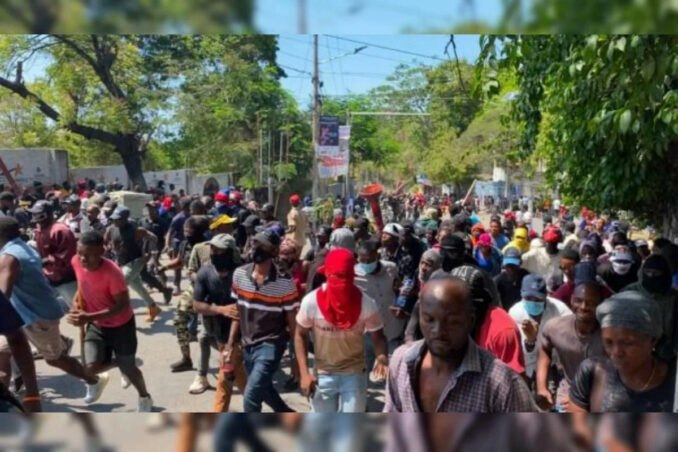The corporate press in both the United States and France present the political situation in Haiti as a struggle between the so-called official government and an alliance of heavily armed criminal “gangs” called Viv Ansanm (“Live together” in Creole), which is on the verge of seizing control of Port-au-Prince. These reports don’t mention that the term of the last elected official in the government of Haiti ended January 18, 2023, and that the arms Viv Ansanm uses are imported “illegally” from Florida.

Police attack Canapé-vert march, killing one organizer, Haiti, March 19, 2025.
In the absence of elections, the government gets its “bourgeois legitimacy” from the Core Group, an imperialist body that has set Haiti’s political and economic trajectory following the 2004 coup against democratically elected President Jean Bertrand Aristide. The Core Group, dominated by the U.S. and France, is made up of representatives from Brazil, Canada, France, Germany, Spain, the European Union, the United States and the Organization of American States. Notably absent are Haiti and any other Caribbean country.
The Haitian masses in March have begun to take to the streets and directly intervene in this struggle.
According to Henriot Dorcen: “Haiti’s strife and chaos are in large part the result of a profound popular uprising … led by an array of ‘ghetto’ armed groups with different histories, ethics, levels of discipline, ideological outlooks, leadership styles and survival strategies. But they all now agree (at least in principle) that Haiti’s ‘system’ must change, and they are not willing to surrender the power that they now wield.” (Haïti-Liberté, March 12)
Léogâne and Carrefour
On March 12 in Léogâne, a small city about 20 miles southwest of Port-au-Prince, demonstrators took to the streets to protest “insecurity in the metropolitan area,” claiming that the government is contributing to insecurity because it wants the people to give up and request a U. S. military occupation.
A week or so later in Carrefour, another small city between Léogâne and Port-au-Prince, a Kenyan soldier from the United Nations-endorsed Multinational Security Support Mission (MSS) was killed in an ambush of his U.S. supplied Armored Personnel Carrier.
Canapé-vert march attacked by police
Canapé-vert is a working-class community in eastern Port-au-Prince, south of the U.S. Embassy. According to a post by the Haiti Info Project: “On Wednesday, March 19, at the initiative of members of the population of Canapé-vert and Bourdon, a large march took place in the streets of the capital [Port-au-Prince] to denounce armed violence and also the inability of the authorities in place to resolve the security crisis.
“Armed with machetes and sticks, the angry protesters denounced the laxity of the Transitional Presidential Council and the head of government. … ‘If the authorities cannot take concrete and urgent measures to neutralize the bandits, they must bow out,’ the protesters insisted, expressing their desire to return to their homes.
“The protesters chanted slogans denouncing the Core Group, blaming its member countries for Haiti’s deteriorating security situation. They also held up pictures of Russian President Vladimir Putin. … On the way to the Villa d’accueil in Musseau, the demonstration was brutally dispersed on the Bourdon road by the Haitian National Police, who made excessive use of tear gas.”
Police shot five demonstrators, including one of the demonstration’s organizers Elibert Idovic, 35, who was shot in the abdomen and died.
Over one million Internally Displaced People
The U.N.’s International Organization for Migration (IOM) estimates that 1.04 million people, many displaced multiple times, make up this intensifying humanitarian crisis in Haiti. Children are over half of the displaced population.
Displacement rose from 315,000 in December 2023 to over a million today. In Port-au-Prince alone, displacement has nearly doubled, rising by 87%, fueled by relentless violence, worsening food insecurity and the collapse of essential services — particularly health care.
The 20,000 Haitians recently deported from the U. S. have had major problems in rejoining Haitian society and finding work. The 500,000 Haitians with Temporary Protective Status (TPS) that the Trump administration plans to deport beginning in August 2025 are going to have even more severe problems finding jobs and housing.
Food insecurity and health care
Food insecurity is growing in Haiti. The World Food Organization reports that 4.7 million Haitians, out of a total population of around 11 million, face severe hunger. They don’t have access to enough food — or water — to eat three meals a day.
The Trump-Musk suspension of U. S. Agency for International Development funding means that four tons of bean seeds, which World Relief has stored in Haitian warehouses, will not be distributed to Haitian farmers who are entering their planting season. Funding from USAID coming through World Relief also supported 40% of primary care services and 170 clinics in Haiti.
Secretary of State Marco Rubio’s campaign against Cuban doctors and medical workers, who provide much of the medical care in Haiti, will make the effects of this funding shortfall even more severe.
Haiti’s General Hospital was originally built by the U. S. Army’s Corps of Engineers during the U. S. occupation of Haiti (1915-1934). One of its main buildings was destroyed in the 2010 earthquake. It took a long time for the hospital to be repaired, and its reopening was disrupted by an armed attack. An older building was burned, the new building ransacked, and the hospital is not fully functional.
Cholera was introduced to Haiti by U.N.peacekeepers in 2011, which the U.N. admitted five years later. Cholera killed at least 10,000 Haitians and sickened hundreds of thousands. Not endemic before the U.N. introduced it, Medecins Sans Frontière[Doctors Without Borders] says cholera again is on the rise in Haiti with 150 Haitians being treated for cholera between Feb. 15 and March 6, 2025. There were 19 cases in Cité Soleil, Haiti’s poorest community.
